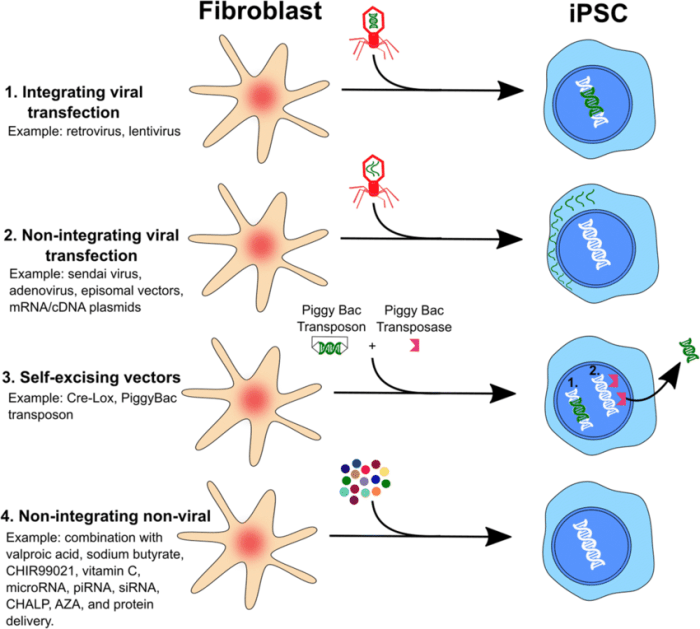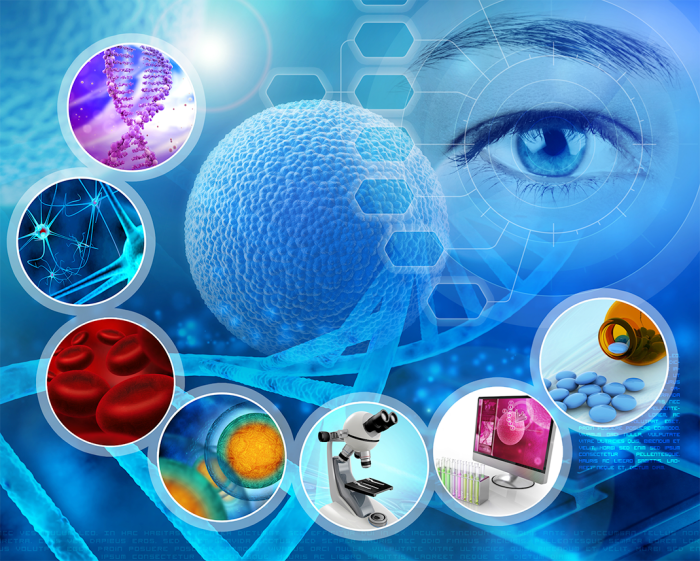
Stem cell research, a field brimming with potential, is rapidly transforming medicine. From understanding the intricacies of different stem cell types to developing innovative therapies, advancements are reshaping our approach to treating a wide range of diseases. This exploration delves into the remarkable progress made in stem cell isolation, culture, differentiation, and their application in regenerative medicine, highlighting both the breakthroughs and the ongoing challenges.
The journey into the world of stem cells unveils a fascinating interplay between basic science and clinical application. We’ll examine the diverse types of stem cells, their unique properties, and the ethical considerations surrounding their use. Further, we will investigate the innovative techniques employed in isolating, culturing, and differentiating these cells, paving the way for groundbreaking therapies. The potential to repair damaged tissues and organs, offering hope for previously incurable diseases, is a driving force behind this exciting field.
Stem Cell Differentiation and Applications

Stem cell differentiation, the process by which a stem cell develops into a more specialized cell type, is a cornerstone of regenerative medicine and holds immense potential for treating a wide range of diseases. This remarkable ability arises from the stem cell’s plasticity, its capacity to adopt various cell fates depending on the signals it receives from its environment.
Understanding and controlling this process is crucial for harnessing the therapeutic potential of stem cells.Stem cell differentiation is a complex, multi-step process involving intricate signaling pathways and gene expression changes. External factors, such as growth factors and extracellular matrix components, play a crucial role in guiding the differentiation process, essentially instructing the stem cell which specialized pathway to follow.
Internal factors, including the cell’s epigenetic landscape and inherent genetic predisposition, also contribute significantly to the ultimate cell fate. This intricate interplay between internal and external cues ensures the precise and controlled generation of specific cell types.
Disease Modeling Using Stem Cell Differentiation
Induced pluripotent stem cells (iPSCs), derived from adult cells reprogrammed to an embryonic-like state, have revolutionized disease modeling. Researchers can now generate patient-specific iPSCs, which carry the genetic makeup of individuals with specific diseases. These iPSCs can then be differentiated into the relevant cell types affected by the disease, creating in vitro models that accurately reflect the disease’s pathophysiology.
For example, iPSCs from patients with Parkinson’s disease can be differentiated into dopaminergic neurons, allowing researchers to study the specific cellular mechanisms underlying neuronal degeneration. This approach bypasses the limitations of animal models and allows for the testing of potential therapies in a more human-relevant context. Similarly, modeling cardiovascular diseases using iPSC-derived cardiomyocytes allows for the investigation of the impact of genetic mutations on cardiac function.
Stem Cell Therapy for Disease Treatment
Stem cell therapy holds tremendous promise for treating a variety of debilitating diseases. The ability to generate specific cell types from stem cells offers a potential solution for replacing damaged or diseased tissues.
Examples of Successful Clinical Trials Using Stem Cell Therapy
Several clinical trials have demonstrated the potential of stem cell therapy. While the field is still evolving, these examples highlight the progress made:
- Treatment of macular degeneration: Clinical trials have shown promising results using retinal pigment epithelial cells derived from embryonic stem cells to treat age-related macular degeneration, a leading cause of vision loss. These trials have demonstrated improvements in visual acuity in some patients.
- Treatment of heart failure: Studies have investigated the use of mesenchymal stem cells (MSCs) to improve cardiac function in patients with heart failure. While results have been varied, some trials have shown improvements in ejection fraction and reduced hospitalizations.
- Treatment of type 1 diabetes: Research is ongoing to use stem cells to replace insulin-producing beta cells in patients with type 1 diabetes. While still in early stages, some clinical trials have shown encouraging results in terms of improved glucose control.
Stem Cell-Based Regenerative Medicine

Stem cell-based regenerative medicine harnesses the remarkable ability of stem cells to differentiate into various cell types and repair damaged tissues, offering transformative potential for treating a wide range of diseases and injuries. This field leverages the inherent self-renewal and differentiation capabilities of stem cells to restore function and improve patient outcomes, representing a significant advancement in therapeutic approaches.Stem cells contribute to tissue repair and regeneration through several key mechanisms.
Firstly, they replace damaged or lost cells, restoring tissue architecture and function. Secondly, they secrete a variety of growth factors and cytokines that stimulate the proliferation and differentiation of surrounding cells, promoting tissue remodeling and healing. Thirdly, stem cells can modulate the immune response, reducing inflammation and promoting a more favorable environment for tissue repair. This intricate interplay of cellular replacement, paracrine signaling, and immunomodulation underpins the therapeutic efficacy of stem cell therapies.
Tissue Engineering and Organ Transplantation Using Stem Cells
Stem cells are being used to engineer tissues and organs for transplantation in several innovative ways. For example, in bone regeneration, mesenchymal stem cells (MSCs) are seeded onto biocompatible scaffolds, which provide structural support and allow for the formation of new bone tissue. Similarly, in cartilage repair, chondrocytes derived from stem cells are used to regenerate damaged cartilage in joints, alleviating pain and improving mobility.
More complex approaches involve the generation of functional organs, such as the creation of functional liver tissues from induced pluripotent stem cells (iPSCs) for transplantation in patients with liver failure. While still in early stages for many organs, the potential to generate fully functional organs from stem cells holds enormous promise for addressing organ shortages and improving transplant outcomes.
Efficacy and Safety of Stem Cell Therapies Compared to Traditional Treatments
The efficacy and safety of stem cell-based therapies are being rigorously evaluated in clinical trials. Compared to traditional treatments, stem cell therapies often offer the potential for more complete tissue repair and functional restoration. For instance, in the treatment of heart failure, stem cell injections have shown promise in improving cardiac function and reducing the need for heart transplantation, although the long-term effects are still being investigated.
However, the safety of stem cell therapies is a critical concern, with potential risks including tumor formation, immune rejection, and off-target effects. Rigorous quality control measures, careful patient selection, and ongoing monitoring are essential to ensure the safe and effective application of stem cell-based therapies. The long-term efficacy and safety profiles are still under investigation for many applications and need more comprehensive studies to establish definitive conclusions.
Advancements in Biomaterials for Stem Cell Delivery and Integration
Advancements in biomaterials are playing a crucial role in improving the delivery and integration of stem cells into damaged tissues. Biocompatible scaffolds provide structural support for cell growth and differentiation, mimicking the natural extracellular matrix. These scaffolds can be designed with specific properties to enhance cell adhesion, migration, and differentiation, optimizing the therapeutic effect. For example, hydrogels are being increasingly utilized as delivery vehicles for stem cells due to their ability to mimic the natural tissue environment and their biodegradability.
Furthermore, the incorporation of growth factors and other bioactive molecules into biomaterials can further enhance stem cell function and tissue regeneration. The development of innovative biomaterials is therefore a critical factor in translating the potential of stem cell therapies into effective clinical applications.
Stem cell research stands at the cusp of revolutionizing healthcare. While challenges remain, the remarkable progress achieved in understanding stem cell biology and developing innovative therapeutic strategies offers immense promise. The ongoing refinement of techniques, coupled with advancements in related fields such as biomaterials and gene editing, points towards a future where stem cell-based therapies become commonplace, offering effective and personalized treatments for a wide spectrum of debilitating diseases.
The ethical considerations must continue to be addressed responsibly, ensuring that the immense potential of this field is harnessed for the benefit of humanity.
Question Bank
What are the risks associated with stem cell therapy?
Risks can include immune rejection, tumor formation, and infection. The specific risks vary depending on the type of stem cells used and the treatment approach.
How long does stem cell therapy take to show results?
The timeframe for seeing results varies greatly depending on the condition being treated and the type of stem cell therapy used. Some patients may see improvements relatively quickly, while others may require more time.
Is stem cell therapy covered by insurance?
Insurance coverage for stem cell therapy is highly variable and depends on the specific procedure, the patient’s insurance plan, and the clinical setting. It’s crucial to check with your insurance provider beforehand.
Where can I find clinical trials for stem cell therapy?
ClinicalTrials.gov is a great resource to find registered clinical trials for various stem cell therapies. You can search by condition, location, and other criteria.

